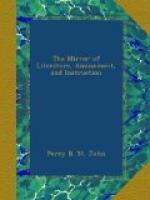Something more than a year after the demise of the Marquess de Montespan, Paris was thrown into considerable consternation by a report originating with some of the petty officers of the sacred establishment, that the church of St. Genevieve was haunted; old Albert Morel, the sexton, protesting upon the faith of a good Catholic, that he had heard, when occasionally in the church, alone, a strange rattling noise proceed from the vaults beneath it. “What this could be,” he remarked, “was past comprehension, unless it were ghosts playing at skittles with their own dead bones.” Some people laughed at this idea, and some sapiently shaking their heads, declared with ominous looks, that Morel was no fool, but knew what he knew, whilst every one agreed that some foundation, at least there must be, for the fearful tale. At length, in the church of St. Genevieve, it became necessary for the interment of some individual of rank, to open the very vault from whence seemed chiefly or entirely to proceed the strange and alarming sounds, and this happened to be that, in which were deposited the mortal remains of the Marquess de Montespan; from his coffin, (a mere wooden shell,) it was now ascertained that the rattling proceeded, and as upon inspection, a hole was observed to have been drilled in the wood, as if by the teeth of some animal, it was judged expedient to open and examine it further. The remains of the marquess were discovered in a state of dry decomposition, with his head as completely severed from his body as if by the stroke of the axe;




